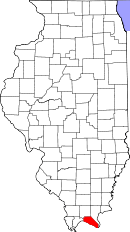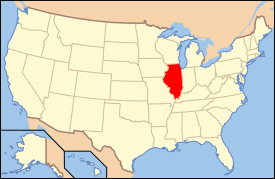Massac County, Illinois
| Massac County, Illinois | |
|---|---|
 Massac County Courthouse | |
 Location in the state of Illinois | |
 Illinois's location in the U.S. | |
| Founded | February 8, 1843 |
| Seat | Metropolis |
| Largest city | Metropolis |
| Area | |
| • Total | 242 sq mi (627 km2) |
| • Land | 237 sq mi (614 km2) |
| • Water | 4.6 sq mi (12 km2), 1.9% |
| Population | |
| • (2010) | 15,429 |
| • Density | 65/sq mi (25/km²) |
| Congressional district | 15th |
| Time zone | Central: UTC-6/-5 |
Massac County is a county located in the state of Illinois. According to the 2010 census, it had a population of 15,429.[1] Its county seat is Metropolis.[2]
Massac County is included in the Paducah, KY-IL Micropolitan Statistical Area. It is located along the Ohio River, in the portion of the state known locally as "Little Egypt".
History
This area was occupied by various cultures of indigenous peoples for thousands of years before European contact. The most complex and last was that of the Mississippian culture, which built the complex mounds and plaza at the Kincaid Site (now a National Historic Landmark). They abandoned the site in about 1500, centuries before European contact.
Part of the Illinois Country was claimed by French explorers; this area was barely settled, with most French colonial villages close to the Mississippi River. During the French and Indian War against the British, the French built a fort here in 1757. It was named Fort Massac after Claude Louis d'Espinchal, Marquis de Massiac, the French Naval Minister.[3] Massiac is a commune in Cantal, France. Fort Massac is also a National Historic Landmark. Although beginning to be settled by European Americans after the American Revolution, Massac County was formally organized on February 8, 1843, out of territory from both Johnson and Pope counties. In the mid-19th century, after the revolutions of 1848, the Midwest received many German immigrants. Their self-identified descendants today comprise nearly one-third of the population of the county. The Elijah P. Curtis House is the third National Historic Landmark in Massac County. Built in 1870, it is located at 405 Market Street in Metropolis, Illinois.
-

Massac County at the time of its creation in 1843
Geography
According to the U.S. Census Bureau, the county has a total area of 242 square miles (630 km2), of which 237 square miles (610 km2) is land and 4.6 square miles (12 km2) (1.9%) is water.[4]
Climate and weather
| Metropolis, Illinois | ||||||||||||||||||||||||||||||||||||||||||||||||||||||||||||
|---|---|---|---|---|---|---|---|---|---|---|---|---|---|---|---|---|---|---|---|---|---|---|---|---|---|---|---|---|---|---|---|---|---|---|---|---|---|---|---|---|---|---|---|---|---|---|---|---|---|---|---|---|---|---|---|---|---|---|---|---|
| Climate chart (explanation) | ||||||||||||||||||||||||||||||||||||||||||||||||||||||||||||
| ||||||||||||||||||||||||||||||||||||||||||||||||||||||||||||
| ||||||||||||||||||||||||||||||||||||||||||||||||||||||||||||
In recent years, average temperatures in the county seat of Metropolis have ranged from a low of 25 °F (−4 °C) in January to a high of 90 °F (32 °C) in July, although a record low of −21 °F (−29 °C) was recorded in January 1984 and a record high of 105 °F (41 °C) was recorded in July 1999. Average monthly precipitation ranged from 3.00 inches (76 mm) in August to 4.76 inches (121 mm) in May.[5]
Major highways
Adjacent counties
- Pope County - north
- Livingston County, Kentucky - east
- McCracken County, Kentucky - south
- Pulaski County - west
- Johnson County - northwest
National protected area
- Shawnee National Forest (part)
Demographics
| Historical population | |||
|---|---|---|---|
| Census | Pop. | %± | |
| 1850 | 4,092 | — | |
| 1860 | 6,213 | 51.8% | |
| 1870 | 9,581 | 54.2% | |
| 1880 | 10,443 | 9.0% | |
| 1890 | 11,313 | 8.3% | |
| 1900 | 13,110 | 15.9% | |
| 1910 | 14,200 | 8.3% | |
| 1920 | 13,559 | −4.5% | |
| 1930 | 14,081 | 3.8% | |
| 1940 | 14,937 | 6.1% | |
| 1950 | 13,594 | −9.0% | |
| 1960 | 14,341 | 5.5% | |
| 1970 | 13,889 | −3.2% | |
| 1980 | 14,990 | 7.9% | |
| 1990 | 14,752 | −1.6% | |
| 2000 | 15,161 | 2.8% | |
| 2010 | 15,429 | 1.8% | |
| Est. 2014 | 14,905 | [6] | −3.4% |
| U.S. Decennial Census[7] 1790-1960[8] 1900-1990[9] 1990-2000[10] 2010-2013[1] | |||
2010
Whereas according to the 2010 U.S. Census Bureau:
- 91.0% White
- 5.9% Black
- 0.4% Native American
- 0.3% Asian
- 0.0% Native Hawaiian or Pacific Islander
- 2.0% Two or more races
- 0.4% Other races
- 1.9% Hispanic or Latino (of any race)
2000
As of the 2010 United States Census, there were 15,429 people, 6,362 households, and 4,242 families residing in the county.[11] The population density was 65.0 inhabitants per square mile (25.1/km2). There were 7,113 housing units at an average density of 30.0 per square mile (11.6/km2).[4] The racial makeup of the county was 91.0% white, 5.9% black or African American, 0.4% American Indian, 0.3% Asian, 0.5% from other races, and 2.0% from two or more races. Those of Hispanic or Latino origin made up 1.9% of the population.[11] In terms of ancestry, 25.7% were German, 16.1% were Irish, 8.5% were English, and 8.5% were American.[12]
Of the 6,362 households, 30.8% had children under the age of 18 living with them, 50.3% were married couples living together, 12.0% had a female householder with no husband present, 33.3% were non-families, and 29.2% of all households were made up of individuals. The average household size was 2.38 and the average family size was 2.91. The median age was 42.1 years.[11]
The median income for a household in the county was $41,077 and the median income for a family was $51,794. Males had a median income of $46,231 versus $25,717 for females. The per capita income for the county was $20,216. About 9.7% of families and 13.7% of the population were below the poverty line, including 21.5% of those under age 18 and 11.7% of those age 65 or over.[13]
Communities
Cities
Village
Unincorporated communities
- Bargerville
- New Liberty
- Round Knob
- Shady Grove
- Unionville
See also
References
- 1 2 "State & County QuickFacts". United States Census Bureau. Retrieved July 7, 2014.
- ↑ "Find a County". National Association of Counties. Retrieved 2011-06-07.
- ↑ Gannett, Henry (1905). The Origin of Certain Place Names in the United States. U.S. Government Printing Office. p. 202.
- 1 2 "Population, Housing Units, Area, and Density: 2010 - County". United States Census Bureau. Retrieved 2015-07-12.
- 1 2 "Monthly Averages for Metropolis, Illinois". The Weather Channel. Retrieved 2011-01-27.
- ↑ "Annual Estimates of the Resident Population for Incorporated Places: April 1, 2010 to July 1, 2014". Retrieved June 4, 2015.
- ↑ "U.S. Decennial Census". United States Census Bureau. Retrieved July 7, 2014.
- ↑ "Historical Census Browser". University of Virginia Library. Retrieved July 7, 2014.
- ↑ "Population of Counties by Decennial Census: 1900 to 1990". United States Census Bureau. Retrieved July 7, 2014.
- ↑ "Census 2000 PHC-T-4. Ranking Tables for Counties: 1990 and 2000" (PDF). United States Census Bureau. Retrieved July 7, 2014.
- 1 2 3 "DP-1 Profile of General Population and Housing Characteristics: 2010 Demographic Profile Data". United States Census Bureau. Retrieved 2015-07-12.
- ↑ "DP02 SELECTED SOCIAL CHARACTERISTICS IN THE UNITED STATES – 2006-2010 American Community Survey 5-Year Estimates". United States Census Bureau. Retrieved 2015-07-12.
- ↑ "DP03 SELECTED ECONOMIC CHARACTERISTICS – 2006-2010 American Community Survey 5-Year Estimates". United States Census Bureau. Retrieved 2015-07-12.
 |
Johnson County | Pope County |  | |
| Pulaski County | |
Livingston County, Kentucky | ||
| ||||
| | ||||
| McCracken County, Kentucky |
| |||||||||||||||||||||||||
Coordinates: 37°13′N 88°43′W / 37.22°N 88.71°W